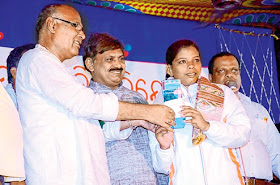Introduction
Sports medicine is not described as such in ancient or modern medicine. Sports medicine is nothing but the application of various medical principles to the sports activities, physical exercise and performance endeavours.
Updhatu
There are seven dhatu (body-tissues) that give form and shape to the human body. These are seven in number
- Rasa Dhatu (plasma)
- Rakta Dhatu (blood)
- Mamsa Dhatu (muscle)
- Meda Dhatu (adipose tissue)
- Asthi Dhatu (bone)
- Majja Dhatu (bone-marrow)
- Shukra Dhatu (seminal and menstrual fluid)
Each of 7 dhatu nourishes and supports updhatu (secondary tissue product or a subsidiary tissue) and produce malas (excreta or waste products). The updhatu neither nourish each other nor any other tissue for the matter. The corresponding updhatu of seven dhatu are tabulated below:
Anatomy of the joint
As per Ayurvedic anatomy, snayu is the term reserved for the ligaments and kandra is the term reserved for the tendons. Sports injuries can be included in this category. The branch of the anatomy dealing with the study of the ligaments is called desmology.
Joint basically represents the articular apparatus. Muscles, ligaments, and tendons are included the extra-articular apparatus.
Incidence of sports injury in India
According to one estimate, about 30% of the population in India engage in various sports activities. 60% of the sportsmen sustain various injuries in the sports field. 30% of the above are rendered permanently unfit for further sports life. Moreover, the rest does not fit in the truest sense with existing treatment.
Functions of asthi according to Ayurvedic system of medicine
Bones give our body shape and structure. Ligaments, muscles and tendons are connected to asthi. Having strong bones means having a strong body.
Symptoms of Asthivriddhi include
- Adhyasthi (bony-hypertrophy)
- Adhidanta (extra teeth formation).
Symptoms of Asthikshaya include:
- Asthibhagna (pathological fractures),
- Asthikshaya (osteoporosis),
- Asthitoda (Inflammation of bones and joints),
- Asthivrana (osteomyelitis),
- Dwija prapatana (falling of teeth),
- Phakkaroga (rickets),
- Sadana (weakness),
- Srama (fatigue).
Sports injury as per Ayurveda
Concepts of sports injuries and their management can be spotted in the Ayurvedic Samhitas like –
- Bhagna (fractures & dislocations),
- Sadyovrana (acute wounds) etc.
- Snayugata Vaata (Tendon & Ligament injury)
- Vrana (wounds)
- Vranashotha (inflammatory conditions)
Sports Injury Related Conditions in Ayurveda
- Bhagna: Bony injuries
- Kandaragatvata : Tendon injury Ligament versus tendon
- Mamsagatvata : Sprain, & Fatigue syndrome
- Sandhimukta: Joint injuries (dislocation, & subluxation).
- Snayugatvata : Ligament, Nerve & Bursa injuries
Ligament vs tendon
A tendon is a fibrous connective tissue, helping in the attachment of the muscle to bone. Further, tendons also help attach the muscles to structures for example, the eyeball. A tendon helps in the movement of the bone. A ligament is a connective tissue which helps in attachment of one bone with another, and helps in holding the structures together and keeps them stable.
Snayu Marma
Snayu Marma, best defined as vital points, explains the significance of the ligaments which needs protection at any cost. Clinical manifestations sciatica and paralysis occur due to the impaired function of the ligaments along with tendons and blood vessels.
Sanayugata-vata or Vatavrit sanayu roga
Vatavrit sanayu roga or sanayugata-vata is a characterised by musculoskeletal pain and fatigue of wide-spread nature, which strikes in 5% percent of the total population.
Types of ligament as per Ayurveda
Snayu has been mentioned as Vaatavahini Nadi in Ayurveic anatomy (the structures carrying vata, the biological air). In Ayurvedic anatomy, four types of snayu have been described.
- Pratanavathi Snayu: These are branched and are present in all joints of the body and the extremities.
- Vrutha Snayu: These are circular in shape and are precisely as Kandara as per Ayurvedic anatomy.
- Sushira Snayu: They are porous in nature and are located in the end part of stomach, intestines and the urinary bladder.
- Pruthu Snayu: They are flat in nature and are located in the head, chest, sides, and back.
Allopathic Treatment of Sports Injuries
P = Protection
R = Rest
I = Ice
C = Compression
E = Elevation
M= Medication
M= Modalities
Ayurvedic Treatment of Sports Injuries
Ayurveda as a sports medicine is a relatively new concept – although ancient India relied upon this system to treat and maintain the well being of its warrior folk – and it focuses on health aspects of sports persons, such as, their stamina, flexibility and endurance. It is not only curative and rehabilitative, but also preventive.
- Prakritisthaapana: To regain physical fitness of a sports person and send him back to the field as early as possible by protection, rest, medication and physiotherapy.
- Internal Medication: The chief aim is
- To boost up tissue healing,
- To alleviate pain,
- In order to strengthen the injured part.
- External Therapies: The chief aim is
- To alleviate pain
- Strengthens joints
- To improve function
- Lepana / Aalepa / Upanaha: The chief aim is
- To alleviate pain
- To promote tissue healing
- Kati vasti: It is very effective in low back pain, muscular pain and fatigue syndrome.
- Bandhana: Bandage with or without oil massage. 15 types of Vrana Bandhana are described in Ayurveda.
- Anushastra Karma: These include Para Surgical Procedures including agnikarma (direct heat application) and Raktamokshana: (Blood Letting Therapy). Both reduce inflammation, alleviate pain and promote healing.
Conclusion
Snayu (ligaments) present in the human body is closely allied to the biological air, the vata. Snayu is one of the extra-articular or subsidiary tissues, mostly involved in sports injury. The study of human-anatomy is very much vital for preventive and curative aspect. Knowledge of snayu (ligaments) is very important for Ayurvedic physicians who are dealing with treatment of sports injury.










